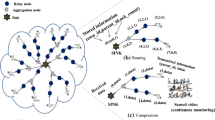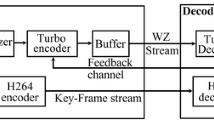Abstract
The next generation of sensor node such as Lotus mote enables higher performance, low power consumption, higher storage/memory and higher speed processing capability than the older generation, such as TelosB or MicaZ motes, which facilitates multimedia data pre-processing and compression in wireless multimedia sensor network (WMSN). In WMSNs, multimedia compression is the main issue that performed on a multimedia sensor node because the complexity of multimedia coding can cause a major energy consumption problem. This paper proposes an optimal complexity H.264 encoding for video streaming over next generation of WMSN. It develops the mathematical model for achieving optimal complexity encoding and proposed the most reliable H.264 encoder configuration setting on H.264 coding. The proposed mechanism ensures an optimal encoding complexity, less power consumption and visual quality of the multimedia. The experimental results of this research give an evidence to verify that the proposed mechanism guarantees high QoS performance.




Similar content being viewed by others
References
Akyildiz, I.F., Melodia, T., Chowdury, K.R.: Wireless multimedia sensor networks: a survey. Wirel. Commun. 14(6), 32–39 (2007)
Costa, D.G., Guedes, L.A.: A survey on multimedia-based cross-layer optimization in visual sensor networks. Sensors 11(5), 5439–5468 (2011)
Wu, F., Hong, W.D.: A survey on the nodes of wireless multimedia sensor networks. Int. J. Adv. Comput. Technol. 5(5), 1260–1275 (2013)
IEEE 802.15.4 Standard, 2003, Part 15.4: Wireless medium access control (MAC) and physical layer (PHY) specifications for Low-Rate Wireless Personal Area Networks (LR-WPANs), IEEE Standard for Information Technology, IEEE-SA Standards Board
Graf, M.: VBR video over ATM: reducing network resource requirements through end system traffic shaping, INFOCOM ’97, pp. 48–57 (1997)
Shen, H., Bai, G., Zhao, L., Tang, Z.: An adaptive opportunistic network coding mechanism in wireless multimedia sensor networks. Int. J. Distrib. Sens. Networks 1–13 (2012)
Pudlewski, S., Prasanna, A., Melodia, T.: Compressed-sensing-enabled video streaming for wireless multimedia sensor networks. Trans. Mobile Comput. 11(6), 1060–1072 (2012)
Xue, Z., Loo, K.K., Cosmas, J., Yip, P.Y.: Distributed video coding in wireless multimedia sensor network for multimedia broadcasting. WSEAS Trans. Commun. 7(5), 418–427 (2008)
Ostermann, J., Bormans, J., List, P., Marpe, D., Narroschke, M., Pereira, F., Stockhammer, T., Wedi, T.: Video coding with H.264/AVC: tools, performance, and complexity. Mag. Circuits Syst. 4(1), 7–28 (2004)
Ma, Z., Hu, H., Wang, Y.: On complexity modeling of H.264/AVC video decoding and its application for energy efficient decoding. Trans. Multimed. 13(6), 1240–1255 (2011)
Semsarzadeh, M., Hashemi, M.R., Shirmohammadi, S.: A generic, comprehensive and granular decoder complexity model for the H.264/AVC standard. J. Vis. Commun. Image Represent. 25(7), 1686–1703 (2014)
Li, X., Wien, M., Ohm, J.-R.: Rate-complexity-distortion optimization for hybrid video coding. IEEE Trans. Circ. Syst. Video Technol. 21, 957–970 (2011)
Balaji, L., Thyagharajan, K. K.: H.264 SVC complexity reduction based on likelihood mode decision. Sci. World J. 1–10 (2015)
Correa, G., Assuncao, P., Agostini, L., Silva Cruz, L.A.: Performance and computational complexity assessment of high-efficiency video encoders. Trans. Circuits Syst. Video Technol. 22(12), 1899–1909 (2012)
Tan, Y. H., Lee, W. S., Tham, J. Y., Rahardja, S., Lye, K. M.: Complexity scalable H.264/AVC encoding. Trans. Circuits Syst. Video Technol. 20 (9), 1271–1275 (2010)
Su; L., Lu, Y., Wu, F., Li, S., Gao, W.: Complexity-Constrained H.264 Video Encoding, Trans. On Circuits and Systems for Video Technology, 19(4), 477–490 (2009)
Pu, W., Lu, Y., Wu, F.: Joint power-distortion optimization on devices with MPEG-4 AVC/H.264 codec, ICC’06, Istanbul, 441–446 (2006)
He, Z., Liang, Y., Chen, L., Ahmad, I., Wu, D.: Power-rate-distortion analysis for wireless video communication under energy constraints. IEEE Trans. Circ. Syst. Video Technol. 15, 645–658 (2005)
Maierbacher, G., Barros, J.: Low-complexity coding and source-optimized clustering for large-scale sensor networks. ACM Trans. Sen. Netw., 5(3), 24.1-24.32 (2009)
Lee, H., Jung, B., Jung, J., Jeon, B.: Computational complexity scalable scheme for power-aware H.264/AVC encoding, IEEE International Workshop on Multimedia Signal Process, 1–6 (2009)
Yu, H., Qing, L., Ma, S., Jay Kuo, C. C.: Joint rate-distortion-complexity optimization for H.264 motion search, ICME’06, 1949–1952 (2006)
Sadasican, S.: An Introduction to the ARM Cortex-M3 Processor, ARM white paper, 1–17 (2006)
Burd, T., Broderson, R.: Processor design for portable systems”. J. VLSI Signal Process 13(2), 203–222 (1996)
Horowitz, M., Joch, A., Kossentini, F., Hallapuro, A.: H.264/AVC baseline profile decoder complexity analysis, Trans. In Circ. Sys. Video Technol., 13(7), 704–716 (2003)
MEMSIC Technology, http://www.memsic.com/products/wireless-sensor-networks.html. Accessed on March 2015
Ahmed, A., Fisal, N.: A real-time routing protocol with load distribution in wireless sensor networks. Elsevier Comput. Commun. J. 31(14), 3190–3203 (2013)
Ahmed, A., Fisal, N.: A real-time routing protocol with mobility support and load distribution for mobile wireless sensor networks. Int. J. Sens. Netw. 15(2), 95–111 (2014)
Ahmed, A.: A comparative study of QoS performance for location based and corona based real-time routing protocol in mobile wireless sensor networks”. Wirel. Netw. J. 21(3), 1015–1031 (2015)
http://videocoders.com/yuv.html. Accessed on Dec 2015
Author information
Authors and Affiliations
Corresponding author
Rights and permissions
About this article
Cite this article
Ahmed, A.A. An optimal complexity H.264/AVC encoding for video streaming over next generation of wireless multimedia sensor networks. SIViP 10, 1143–1150 (2016). https://doi.org/10.1007/s11760-016-0870-0
Received:
Revised:
Accepted:
Published:
Issue Date:
DOI: https://doi.org/10.1007/s11760-016-0870-0




